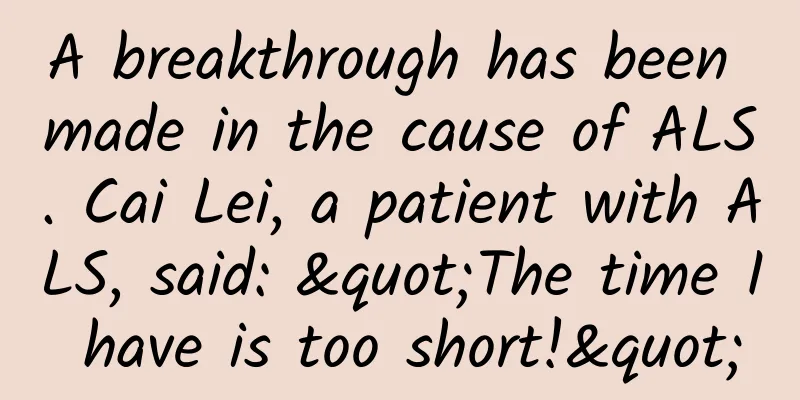A breakthrough has been made in the cause of ALS. Cai Lei, a patient with ALS, said: "The time I have is too short!"

|
"The time I have is too short!" This is the feeling expressed by Cai Lei, former vice president of JD.com and ALS patient, recently. Facing the ruthless attack of ALS, although his body is getting weaker and weaker, he has great ambitions and vows to "fight the last blow with all his strength against death". Today, we will walk into Cai Lei's world together and witness how he promoted the scientific research process with practical actions in the dilemma of ALS being incurable, and the recent major discovery of the new cause of ALS , which brings new hope for the road to cure. “Icebreaker” Cai Lei: Five years of racing against time A year ago, Cai Lei's book "Believe" was published. At that time, he could still speak clearly and tell the story of his struggle with ALS. Now, when CCTV news reporters visited him again, Cai Lei's words were unclear, but his eyes were shining with determination and unyielding light. This former business elite is now in the late stage of ALS. His tongue and lower lip have atrophied, and he needs to use all his strength to speak. He has to rely on a ventilator to fall asleep at night and wake up at four or five in the morning. The curvature of his spine makes it difficult for him to stand or sit, and taking a shower has become his biggest problem. But even though his health is getting worse, Cai Lei has never stopped working. He still insists on working with his key colleagues until ten or eleven every day to contribute his own strength to conquering ALS. Cai Lei's worsening condition is the result of the ruthless destruction of the cruel disease of ALS. Amyotrophic lateral sclerosis (ALS), a problem that the medical community has not yet solved, has plunged countless patients into despair. Cai Lei's experience is just a microcosm of many ALS patients. They suffer from the pain of gradual stiffness of the body and loss of function, but there is no medicine to cure them, and they can only watch their lives slip away bit by bit. However, Cai Lei did not bow to fate. He chose a path that few people take - promoting drug research and trying to overcome ALS. He knows that this road is full of thorns, but he is willing to work hard for the chance to survive. At the beginning of this year, Cai Lei announced that he and his wife would donate another 100 million yuan to support research projects to overcome ALS. A small part of this money came from the royalties of "Believe", and most of it came from the live broadcast of "Ice Breaking Station". He used practical actions to illustrate what he wrote in "Believe": "The stove will not be cleaned just because someone is seriously ill, and the bottled water still needs to be replaced after drinking, and life must go on as usual." The sun shone through the window onto Cai Lei's face, and he said with difficulty: " I still look forward to the day when I can get rid of ALS before I collapse. " New discovery: Nucleolar stress and "toxic" proteins, new clues to the pathogenesis of ALS So why is ALS so difficult to cure? Amyotrophic lateral sclerosis (ALS, commonly known as "Lou Gestational Frost") is a progressive and fatal neurodegenerative disease, listed by the World Health Organization as one of the five terminal illnesses along with AIDS, cancer, leukemia, and rheumatoid arthritis. So far, there is no effective treatment for the disease, and about 80% of patients will die within 5 years of onset. The medical community has not been able to completely uncover the cause of ALS, let alone find effective drugs to block the progression of the disease. However, the pace of scientific exploration has not stopped. Recently, a study published in the journal Molecular Cell found new pathogenic clues to ALS: nucleolar stress and abnormal accumulation of ribosomal proteins . The nucleolus is a key structure in the cell nucleus responsible for ribosome biogenesis. With age, the nucleolus is susceptible to external interference, resulting in impaired cell function. For neurons with extremely high demands for protein translation, any slight change in the nucleolus may trigger a chain reaction, causing significant damage to neuronal function. Studies have found that "toxic" ribosomal proteins accumulated in motor neurons may be the culprit of ALS. These proteins accumulate excessively, inhibit normal cell function, and cause neuronal collapse. Previous studies have found that many hereditary ALS patients carry a C9ORF72 gene mutation, which causes arginine-rich polypeptide fragments to accumulate in the nucleolus, destroying nucleolar function and inducing cell death. In the experiment, when a large number of such polypeptides were introduced into the cells, nucleolar stress was indeed induced, ribosome assembly was blocked, a large number of free ribosomal proteins accumulated, destroyed the cell waste removal system, and ultimately led to cell death. This new discovery reveals the similarities between ALS and ribosomal diseases, and provides new ideas for the development of new therapies. Conclusion Cai Lei, a "lone hero" among patients with rare diseases, not only inspires others with his own experience in fighting the disease, but also promotes scientific research progress with practical actions. He contacts doctors and scientists, personally devotes himself to research, and sets an example for patients with rare diseases: "All sectors of society have insufficient investment in rare diseases, but if patients do not work hard, how can we expect more people to work hard? You should take the initiative and do not wait and rely on others." The "Charitable Trust for Overcoming ALS" he founded aims to sustainably support related scientific research work, and even on the day he falls ill, he can ensure that there will be successors to continue this "ice-breaking" battle. Cai Lei knows that scientific research breakthroughs are not achieved overnight, but require long-term investment and patience. He said frankly: " Many things are not achieved overnight. If there are results in two or three years, it would have been done long ago. But someone has to do it, right? " He firmly believes that it is this perseverance and persistence that will make it possible to push forward the research on rare diseases and lay the foundation for the future cure. He ignited the fire of hope with the last strength of his life, and hoped that future generations would take over the baton and continue the race against "ALS". |
<<: On World Malaria Day, let’s review the development process of the antimalarial drug artemisinin
>>: Once confused due to menopause
Recommend
What to do if a pregnant woman has diarrhea
What should pregnant women do if they have diarrh...
What causes left side low back pain in women?
The female waist involves many organs. Therefore,...
What are the characteristics of infertility?
In daily life, some women always have difficulty ...
Demonstration picture of sleeping on the left side during pregnancy
The sleeping position needs to be changed after p...
What's wrong with slight fetal movement?
The fetal movement is different for women at each...
Treatment of spinal pain after cesarean section
Many of us who have had caesarean sections may be...
Messi hasn't drunk soda or eaten pizza for 8 years. What should athletes pay attention to in their diet?
China Science and Technology News Network, Novemb...
Is my breast always hurting a lump? How to self-check?
Women always suffer more diseases during their me...
Women, how do you retain estrogen?
Estrogen loss: About one-third of women between t...
What should I do if my baby’s nipples hurt when feeding?
Breastfeeding is a very natural behavior for babi...
Is urinary incontinence normal in old age? Don’t suffer in silence, there are many ways to treat it!
Author: Gao Guolan, Chief Physician, West China S...
Hitwise: Comparison of monthly visits to Quora and Yahoo Answers from November 2010 to November 2011
Quora's traffic performance from November 201...
Pregnancy 50 days, spotting, is it a boy?
Red is really an unexpected color. Generally, red...
How to treat breast cancer recurrence
Breast tumor is a type of disease that causes gre...
Is it good to put the "Smooth Sailing" in the bedroom at night? What kind of soil is suitable for "Smooth Sailing"?
Spathiphyllum is also called Peace Lily. It has g...









